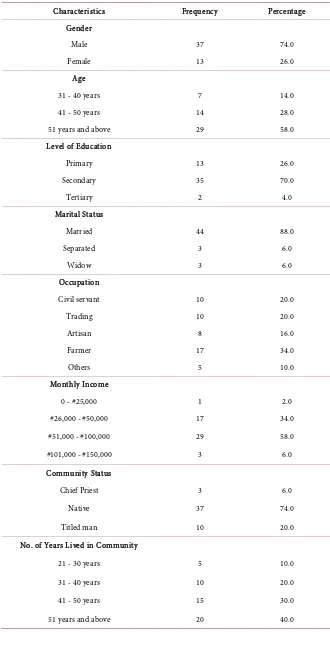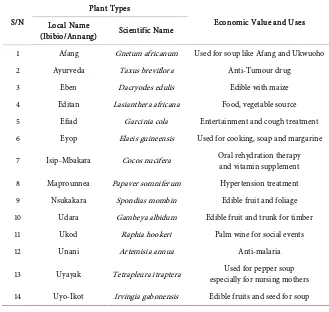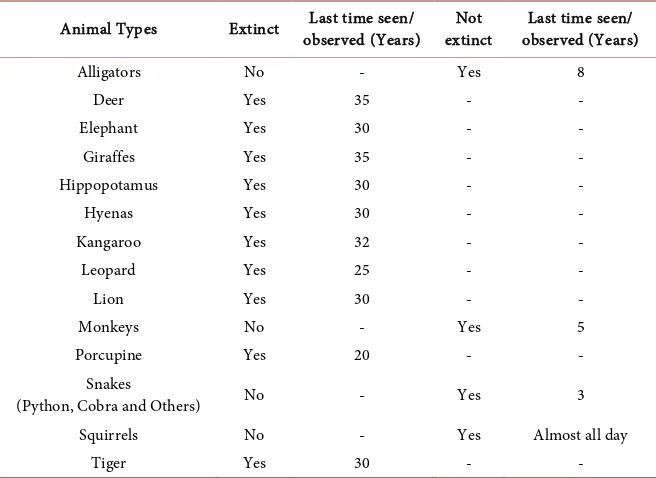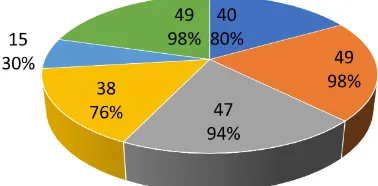http://www.scirp.org/journal/nr ISSN Online: 2158-7086
ISSN Print: 2158-706X
DOI: 10.4236/nr.2019.105010 May 23, 2019 139 Natural Resources
Perception Assessment of the Impact of Human
Activities on Stubbs Creek Forest Reserve,
Akwa Ibom State, Nigeria
David Udoma-Michaels*, Benjamin Ndukwu, Andrew Obafemi
Institute of Natural Resources, University of Port Harcourt, Port Harcourt, Nigeria
Abstract
Perception assessment of the impacts of human activities on Stubbs Creek Forest Reserve (SCFR) which is located between latitude 4˚32'N and 4˚40'N and longitude 7˚48'E and 8˚20'E (Figure 1) distributed into four Local Gov-ernment Areas-Eket, Esit Eket, Ibeno and Mbo of Akwa Ibom State was car-ried out. Structural questionnaires to extract the common types of useful plants and animals, status of the protected area, derivable benefits and ways of preserving the SCFR were ministered to Chiefs Priests, Local Chiefs, El-derly People and Farmers who lived at least twenty years in the areas. Conve-nient sampling method was used to randomly select fifty respondents for the study. Descriptive statistics to summarize feedbacks from respondents pre-sented in the form of tables, charts and histogram in line with the SCFR anthropogenic activities assessment indicators showing percentages and fre-quencies of such response was employed for data analyses and presentation. The results showed that the Stubbs Creek Forest Reserve have been disturbed and degraded due to uncontrolled human activities. Endangered fauna spe-cies including the Giraffa camelopardalis (Giraffe), Hippopotamus amphi-bious (Hippopotamus), Loxodonta africana (Elephant), Hynas, Kangaroo, Panther pardus (Leopard), Panther leo (Lion), Porcupine and Tiger were last seen between twenty and thirty five years ago in the forest while some useful plants of huge economic and medicinal values like Irvingia gabonensis (Bush mango) Tetrapleura itraptera, Gambeya albidum, Raphia hookeri (Rafia palm), Garcinia cola (Bitter kola) and Dacryodes edulis (Native pear) etc were last observed about eleven to twenty years ago. The study further revealed that Monkeys and Alligators are still very common in the Forest Reserve. It, therefore, recommends the strengthening and enforcement of regulatory controls on the use of SCFR by relevant authorities and alternative source of
How to cite this paper: Udoma-Michaels, D., Ndukwu, B. and Obafemi, A. (2019) Perception Assessment of the Impact of Human Activities on Stubbs Creek Forest Reserve, Akwa Ibom State, Nigeria. Natural Resources, 10, 139-152.
https://doi.org/10.4236/nr.2019.105010
Received: April 15, 2019 Accepted: May 20, 2019 Published: May 23, 2019
Copyright © 2019 by author(s) and Scientific Research Publishing Inc. This work is licensed under the Creative Commons Attribution International License (CC BY 4.0).
DOI: 10.4236/nr.2019.105010 140 Natural Resources firewood to reduce anthropogenic abuses and protect the rich resources of the forest from extinction.
Keywords
Perception, Stubbs Creek, Forest Reserve, Human Activities, Endangered
1. Introduction
Akwa Ibom State where SCFR is located lies within Latitudes 4˚32' N, 5˚33'N and Longitudes 7˚25'E, 8˚25'E of the equator and endowed with rich forests re-sources which her people exploit for varying purposes. The value of forest and forest products widely used for traditional, ecological, environmental, economic and medicinal purposes to mankind is vastly documented in many kinds of literature by different authors [1]-[6].
Human activities which involve clearing of vegetation for farming, logging, bush burning, petroleum exploitation and associated oil spill pollution, road construction, urbanization and industrialization have continued to cause forest depletion, and are always impacting negatively on forests resources [7] [8]. Un-fortunately, SCFR—The study area which has been the largest forest reserve not only in Akwa Ibom State but the entire Eastern part of Nigeria with original size of 310.80 km2 in 1930, have reduced significantly due to these anthropogenic
ac-tivities [9] [10]. Recent study carried out to identify, classify and evaluate the land cover status of the reserve using the Remote Sensing technologies showed that there are two fundamental vegetation covers namely; the dense vegetation cover and sparse vegetation cover while the remaining land covers in the area are simply baresoil and water body [10]. Between 1993 and 2003, the dense ve-getation cover had decreased from 63.50 km2 to 42.43 km2 and between 2003 and
2013; it decreased further to 28.22 km2 whereas the sparse land cover, bare soil
and water body on the contrary, experienced significant increase in land cover classes in the study area within the same period. The study further projected the total disappearance of SCFR by the year 2033 if the observed trend of the Re-serve’s degradation as a result of the increasing rate of anthropogenic activities is not halted to reduce the huge loss of biological diversity and other resources in the Protected Area.
DOI: 10.4236/nr.2019.105010 141 Natural Resources
2. Materials and Methods
2.1. Description of the Study Area
[image:3.595.218.529.265.706.2]The Stubbs Creek Forest Reserve (SCFR) in Akwa Ibom State which can be found between latitude 4˚32'N and 4˚44'N and longitude 7˚48'E and 8˚20'E cut across four Local Government Areas which are: Eket, Esit Eket, Ibeno and Mbo (Figure 1). It features three major vegetation types namely, the Mangrove swamp forest, Freshwater swamp and Tropical rainforest vegetation with various plant and animal species making it one of the major biodiversity hotspots within the Gulf Of Guinea [12]. The total annual rainfall of SCFR ranges from 1700 mm to 4700 mm and mean monthly temperature of 25˚C to 28˚C with well-drained or poorly drained soil thereby making agriculture the main occupation of the
DOI: 10.4236/nr.2019.105010 142 Natural Resources people [13]. It is difficult to see any civil servant from the study area without in-volved in part-time farming. In this way, it might be truly right to state that over 90% of Akwa people, as well as inhabitants, are engaged with agriculture. The SCFR likewise is luxuriously supplied with remarkable Oil and Gas reserves and play host to some global organizations like the Universal Energy Resources Ltd., the administrator of the Stubbs Creek Marginal Field, Frontier Oil Li-mited—Administrator of Uquo Marginal Field and Network E&P, the adminis-trator of Qua Iboe Marginal Field. These fields situated within the SCFR were all homestead-out to the recipients in 2003 [14]. All the three companies have since started exploration and production activities as required. It is reported from re-search that apart from direct destruction of the vegetation to facilitate construc-tion of facilities, such activities may also cause severe consequences to the envi-ronment through the discharge of hydrocarbon and related constituents into the SCFR ecosystem [15].
2.2. Data Gathering and Sampling Procedure
DOI: 10.4236/nr.2019.105010 143 Natural Resources
2.3. Data Analysis
A descriptive statistical tool of percentages and frequencies was used to sum-marize feedbacks from the respondents across the affected communities within the SCFR environment. Questionnaire samples returned were coded, recorded in excel worksheet 2007 and imported into the Statistical Package for Social Scien-tist (SPSS) 24.0 version for effective data analysis and presentation.
3. Results and Discussions
Socio-Economic Characteristics of Respondents
The gender ratio for sampled respondents showed that the total number of sampled males were 74% while the remaining 26% were females. The age ratio of sampled respondents uncovered that 14% of sampled respondents were between the age proportion of 31 - 40 years, 28% of the respondents were between 41 - 50 years while the remaining 58% of examined respondents were either 51 years of age or were over 51 years of age in the study area. The dimension of education among sampled respondents for the investigation demonstrated that 26% of the respondents had secondary level training, 70% of respondents had primary edu-cation, while the remaining 4% of sampled respondents have tertiary level of education in the study area. The conjugal status of respondents for the investiga-tion uncovered that 88% of the respondents were married, 6% of respondents have been separated from their relational unions while 6% of the rest of the res-pondents are widowed. The class of occupation of resres-pondents for the study uncovered that 20% of sampled respondents were government workers, 20% of respondents are into trading, artisanship recorded 16% of the respondents, and respondents who are into farming were 34%, while the outstanding 10% of the respondents were into other occupational types like native medicines and trans-porters. The information for the average monthly income of sampled respon-dents revealed that 2% of responrespon-dents earn between 0 and #25,000, 34% of res-pondents earn between #26,000 and #50,000, 58% of resres-pondents earn between #51,000 and #100,000, while the remaining 6% of respondents earn between #101,000 and #150,000 respectively. The findings on the community status of sampled respondents revealed that 6% of respondents are community chief priest, 74% of respondents were native of the land, while the remaining 20% of respondents have one community title or the other. The information for the number of years lived in sampled communities by respondents revealed that 10% have lived in their community between 21 - 30 years; 20% of respondents have lived between 31 - 40 years; 30% of respondents have lived between 41 - 50 years; while the remaining majority (40%) of respondents have lived for at least 51 years and above (Table 1).
State of Forest Reserve among Sampled Respondents
DOI: 10.4236/nr.2019.105010 144 Natural Resources
Table 1. Socio-economic characteristics of sampled respondents.
Characteristics Frequency Percentage
Gender
Male 37 74.0
Female 13 26.0
Age
31 - 40 years 7 14.0
41 - 50 years 14 28.0
51 years and above 29 58.0
Level of Education
Primary 13 26.0
Secondary 35 70.0
Tertiary 2 4.0
Marital Status
Married 44 88.0
Separated 3 6.0
Widow 3 6.0
Occupation
Civil servant 10 20.0
Trading 10 20.0
Artisan 8 16.0
Farmer 17 34.0
Others 5 10.0
Monthly Income
0 - #25,000 1 2.0
#26,000 - #50,000 17 34.0
#51,000 - #100,000 29 58.0
#101,000 - #150,000 3 6.0
Community Status
Chief Priest 3 6.0
Native 37 74.0
Titled man 10 20.0
No. of Years Lived in Community
21 - 30 years 5 10.0
31 - 40 years 10 20.0
41 - 50 years 15 30.0
DOI: 10.4236/nr.2019.105010 145 Natural Resources undisturbed; 14% of respondents believed that the forests are relatively dis-turbed; while the remaining 64% of respondents (32 in number) were of the opi-nion that the forest reserve has been disturbed and degraded (Figure 2).
[image:7.595.220.526.207.367.2]Perception on the Common Types of Plants That Existed in Forest Reserve The list of common plants types found in the forest reserve as explained by sampled respondents was displayed on (Table 2). The direct values and uses of these plant types are of socio-economic importance to the people, thus, its bene-fits to the local people cannot be over-emphasized.
Figure 2. State of forest reserve in the study area.
Table 2. Some of the common plant types that existed in the study area.
S/N
Plant Types
Economic Value and Uses Local Name
(Ibibio/Annang) Scientific Name
1 Afang Gnetumafricanum Used for soup like Afang and Ukwuoho
2 Ayurveda Taxusbreviflora Anti-Tumour drug
3 Eben Dacryodes edulis Edible with maize
4 Editan Lasiantheraafricana Food, vegetable source
5 Efiad Garciniacola Entertainment and cough treatment
6 Eyop Elaeisguineensis Used for cooking, soap and margarine
7 Isip-Mbakara Cocos nucifera Oral rehydration therapy and vitamin supplement
8 Maprounnea Papaversomniferum Hypertension treatment
9 Nsukakara Spondiasmombin Edible fruit and foliage
10 Udara Gambeyaalbidum Edible fruit and trunk for timber
11 Ukod Raphiahookeri Palm wine for social events
12 Unani Artemisiaannua Anti-malaria
13 Uyayak Tetrapleuraitraptera especially for nursing mothers Used for pepper soup
[image:7.595.207.536.417.729.2]DOI: 10.4236/nr.2019.105010 146 Natural Resources Perception on the Last Time Plants That Are No Longer in Existence Were Noticed among Sampled Respondents
The information for those plants not in existence and when they were last seen was obtained from sampled respondents. It was revealed that 8% of res-pondents were undecided, 16.0% of sampled respondent declared that some of these plants were last seen between 1 to 10 years; 40.0% of respondents believed that they were last seen about 11 years to 20 years ago (this means that more of the economic plants disappeared between year 2000 and year 2017); the remain-ing 36.0% of respondents believed that they were last seen about 21 years and 30 years. Thus, more of these common plants disappeared from 11 to 20 years ago (Figure 3).
Status of Some Animals That Existed/Existing in the Forest Reserve The lists for some of the animals that still exist were identified against the ex-tinct ones (Table 3). The information obtained revealed that certain animals are no longer seen and were last seen about 15 years to 20 years ago. Several types of encroachments were identified as the reason for their disappearance.
Economic Value and Importance of Extinct Plants
The information for the economic value and importance of plant that have faced extinction was obtained from sampled respondents. The information re-vealed that 46% of the respondents highlighted the plants ethno-medicinal value; 10% of the respondents believed in its forest wood value; 16% of the respondents declared on its direct uses as a source of income; while the remaining 28% of the respondents believed on its consumption value as food source (Figure 4).
Change in Forest Size
The forest sizes in the study area are gradually decreasing because the majority of sampled respondents (96%) declared it. However, in some areas, it was observed by 2% of the respondents that the size of the forests was relatively stable. The last 2% of the respondents were not sure about the size if it is reduc-ing or increasreduc-ing in size (Figure 5).
[image:8.595.209.536.543.707.2]Factors Responsible for the Current Size of Forests in the Study Area
DOI: 10.4236/nr.2019.105010 147 Natural Resources
[image:9.595.212.536.256.422.2] [image:9.595.210.538.472.711.2]Figure 4. Economic value and importance of extinct plants.
Figure 5. Is the size of the Forest Increasing or Decreasing?
Table 3. Status of animals that existed/existing in the area.
Animal Types Extinct Last time seen/ observed (Years)
Not extinct
Last time seen/ observed (Years)
Alligators No - Yes 8
Deer Yes 35 - -
Elephant Yes 30 - -
Giraffes Yes 35 - -
Hippopotamus Yes 30 - -
Hyenas Yes 30 - -
Kangaroo Yes 32 - -
Leopard Yes 25 - -
Lion Yes 30 - -
Monkeys No - Yes 5
Porcupine Yes 20 - -
Snakes
(Python, Cobra and Others) No - Yes 3
Squirrels No - Yes Almost all day
Tiger Yes 30 - -
DOI: 10.4236/nr.2019.105010 148 Natural Resources The factors responsible for the current size of forests are listed as: encroach-ment for settleencroach-ment (82%), overgrazing (58%), fire incident 2%, and others (20%) like farming activities, oil production facilities for example (Universal Energy Resources Ltd and Mobil Producing Nigeria Unlimited), logging activi-ties, and some sections fishing activities (Figure 6).
Benefits Derivable from the Forests
The benefits derivable from the forests as in (Figure 7) below includes: provi-sion of food for domestic needs (80%), high medicinal value (98%), tourism (94%), source of income (76%), source of firewood from timber (30%) and oth-ers (98%) which includes protection of flooding, erosion and environmental sa-nitation (air purification).
Do You Think the Forests Should Be Preserved?
The perception of forest protection was examined among sampled respon-dents. It was revealed that 90% of the respondents were of the opinion that the forest should be protected; while the remaining 10% of the respondents were ei-ther not sure (6.0%) of their decision or do not want (4.0%) the protection of these forests (Figure 8).
Suggested Ways of Protecting the Stubbs Creek Forest Reserve
[image:10.595.210.537.496.707.2]The ways of protecting the forested areas were examined among sampled res-pondents for the study. The result obtained showed that 78% of resres-pondents in-dicated enactment and enforcement of laws; 62% inin-dicated preservation of na-tive laws. In addition, while 42% of respondents indicated to avoid encroach-ment by building fences/buffers around protected areas; 28% respondents said to avoid bush burning while 100% of respondents indicated to promote other alternative sources of firewood like cooking gas and stoves; 96% of the respon-dents highlighted other options like creation of more protected lands/areas, pro-mote less cultivation of lands and ensure the planting of more trees (Figure 9).
DOI: 10.4236/nr.2019.105010 149 Natural Resources
[image:11.595.222.536.265.444.2]Figure 7. Benefits derivable from the forests.
Figure 8. Sampled opinions of respondents on whether or not to preserve the forest
[image:11.595.268.450.480.607.2]DOI: 10.4236/nr.2019.105010 150 Natural Resources
4. Conclusions and Recommendations
The state of forest reserve in the study area revealed that it has been disturbed or degraded by human activities as observed by the majority of sampled respon-dents for the study. The study also discovered that due to the high disturbance from human activities most of the common types of native plants and animals have become extinct and were last seen between 10 years and 30 years ago. The socio-economic and medicinal values derived from these forests plants by the local people usually involved such values as: Ethno-medicinal benefits, forest wood, income generation and source of food. Some of the ethno-medicinal val-ues of the local plants names identified were Ayurveda used for treatment of tumour; Maprounnea used for the treatment of hypertension and Unani for ma-laria infections amongst others. According to [17], forests play significant roles in supporting the socio-economic livelihood of the people especially in the rural communities, which its measurements may vary from country to country de-pending on the level of development, social functions and traditions. [15] re-ported huge loss of genetic base or gene bank, decrease in biodiversity, defore-station, siltation of streams and loss of wildlife as consequences of human occu-pational activities within the Stubbs Creek Forest Reserve on the environment which means an automatic reduction in the socio-economic livelihood of the people.
Findings of the study further revealed that the size of the forests is actually reducing over time due to constant deforestation owing to human activities as majority of sampled respondents (96%) indicated reduction in its size. The study also discovered that the Oil and Gas Installations from the Marginal Field Oper-ators like the Universal Energy Resources Ltd, Frontier Ltd and Mobil Producing Nigeria Unlimited occupied a sizeable portion of the Stubbs Creek Forest Re-serve as their activities are among the specific factors responsible for deforesta-tion in the area. Similarly, the percepdeforesta-tion assessment also revealed that en-croachment for settlement, overgrazing, fire incidents and increasing farming activities are other factors adding to the rate of deforestation of the forest re-serve. The findings of the study corroborate with the findings of [9] [18] which reported that a larger chunk of Forest Reserve has been degraded due to human activities like farming, oil production, sand mining etc. Further expansion of such anthropogenic activities would mean more land shall be cleared which au-tomatically will result to reduction in the benefits derived from the forest by the local people.
com-DOI: 10.4236/nr.2019.105010 151 Natural Resources panies, uncontrolled farming and other socio-economic activities from the inha-bitants of the area mean further reduction in plant resources of the forest re-serve. The human activities that contribute to forest degradation and reduction in size should be controlled by enacting and enforcement of relevant laws; edu-cating and encouraging local participation on effective forest management prac-tices as well as provision of alternative source of firewood all to enhance the conservation and preservation of the forest reserve.
Conflicts of Interest
The authors declare no conflicts of interest regarding the publication of this pa-per.
References
[1] Abu, M.A. and Adebisi, K.I. (2002) Economic Contribution of Moringa oieifera
Plantation to Rural Livelihoods in Maradi Local Government Area of Niger Repub-lic. Obeche Journal, 28, 142-146.
[2] Agbogidi, O.M. and Okonta, A.U. (2009) Biodiversity Conservation and Poverty Alleviation in the Niger Delat Are of Nigeria. Agriculturea Conspectus Scientificus, 71, 103-110.
[3] Aimufia, I.A. (2002) The Impact of Climate Change on Forest Resources.
Proceed-ings of the 2nd Biennial National Conference of the Forests and Forest Product
So-ciety of Nigeria. Federal University of Technology, Akure, Nigeria, 26-29 April
2010, 132-135.
[4] Etukudo, I. (2000) Forests: Our Divine Treasure. Dorand Publishers, Uyo,Nigeria. [5] Faleyimu, O.I. and Akinyemi, M. (2014) Socio-Economic Assessment of Urban
Fo-restry Respondents’ Income in Okitipupa, Ondo State,Nigeria. Journal of Applied
Science, Environment and Management, 18, 603-607.
https://doi.org/10.4314/jasem.v18i4.7
[6] Udo, E.S. (2001) The Position of Forestry in Akwa Ibom State. Proceedings of the
1stWorkshop of Forestry Association of Nigeria, Akwa Ibom State Branch in
Col-laboration with the Department of Forestry and Wildlife.University of Uyo, State
Ministry of Environment and the UNDP, Akwa Ibom State held in Uyo, Akwa Ibom State, 10-11 April 2001, 31-43.
[7] Baptista, S.R. (2008) Metropolitan and Forest Recovery in Southern Brazil: A Mul-tiscale Analysis of the Florianopolis City-Region, Santa Catarina State, 1970 to 2005.
Ecology and Society, 13, 14.
file:///C:/Users/u-nel systems/Downloads/ES-2008-2426.pdf
https://doi.org/10.5751/ES-02426-130205
[8] Ekpenyong R.E. (2015) An Assessment of Land Cover Change and Erosion Risk in Akwa Ibom State of Nigeria Using the Co-Ordination of Information on the Envi-ronment (CORINE) Methodology. Greener Journal of Physical Sciences, 3, 76-89. [9] Akpan-Ebe, I.N. (2014) Reforesting the Tropical Rainforest in South-Eastern
Nige-ria. Nigerian Journal of Agriculture, Food and Environment, 10, 128-134.
[10] Ogar, D.A., Asuk, S.A. and Umanah, I.E. (2016) Forest Cover Change in Stubbs Creek Forest Reserve in Akwa Ibom State, Nigeria. Journal of Applied Tropical Agriculture, 21, 183-189.
DOI: 10.4236/nr.2019.105010 152 Natural Resources
[12] Koffi, U.S. (2015) Petroleum Activities, Wetland Utilization and Livelihood Changes in Southern Akwa Ibom State, Nigeria (2003-2015). Lund University, Sweden.
[13] Ukut, A.N., Akpan, U.S. and Udoh, B.T. (2014) Characterization and Classification of Soil in Steep Sided Hills and Sharped-Crested Ridges of Akwa Ibom State, Nige-ria. Net Journal of Agricultural Science, 2, 50-57.
[14] Adava, G., Eze, L.C. and Dominic, E.U. (2017) Overview on the Emergence of Mar-ginal Oil Fields in Nigeria and their Contributions to the Country’s Oil Production.
Nigeria Journal of Oil and Gas Technology, 2, 233.
[15] Essien, B.S. and Udoh, S.O. (2015) Human Occupational Activities in the Stubbs Creek Forest Reserves (scfr) of Akwa Ibom State: Impacts and Implications on So-cio-Economic Environment. International Journal of Development Research, 5, 3880-3887.
[16] Population and Housing Census (2010) Federal Republic of Nigeria, Priority Ta-ble,Vol. 4, 22-34.
[17] Food and Agricultural Organization (FAO) (2005) Global Forest Resources As-sessment 2005, Progress towards Sustainable Forest Management. Chapter 7: So-cio-Economic Functions, 107-108.
[18] Ndoho, J.T., Umoren, V.E. and Adu, E. (2009) Spatial Analysis of Illegal Resource Extraction in Stubbs Creek Forest Reserve in Akwa Ibom State. Nigerian Journal of Agriculture, Food and Environment, 5, 72-78.






